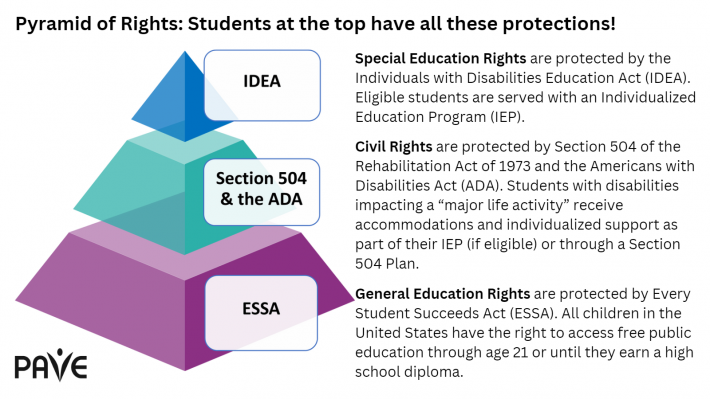A Brief Overview
- Section 504 is part of the Rehabilitation Act of 1973, which is upheld by the U.S. Department of Education’s Office for Civil Rights.
- Section 504 prohibits discrimination based on disability in any program or activity that receives federal funding. All Washington state public schools must comply with this federal law.
- Every student with a disability is protected from discrimination under this law, including each student with a 504 Plan and each student with an Individualized Education Program (IEP).
- Eligibility for Section 504 support at school is determined through evaluation. Washington’s Office of Superintendent of Public Instruction (OSPI) provides fact sheets in multiple languages that describe the evaluation process and state requirements.
- Civil rights complaint options are described at the end of this article.
Full Article
A student with a disability is protected by multiple federal laws. One of them is the Rehabilitation Act of 1973, which is upheld by the U.S. Department of Education’s Office for Civil Rights. Section 504 is part of the Rehabilitation Act and provides key protections against disability discrimination.
To uphold a student’s civil rights under Section 504, schools provide accommodations and support to ensure that a student with a disability has what they need to access the opportunities provided to all students. That support is the essence of equity. Ensuring equity for students with disabilities is part of a school’s responsibility.
Students are protected in their access to academics, social engagement, extracurriculars, sports, events, and more—everything that is part of the school experience and school-sponsored activities.
Every student with a disability is protected from discrimination under this law, including each student with a 504 Plan and each student with an Individualized Education Program (IEP). Section 504 protects a person with disabilities throughout life and covers individuals in any public facility or program. A person can have a 504 Plan to support them in a vocational program, higher education, or in any location or service that receives federal funds.
All people with recognized disabilities also have protections under the Americans with Disabilities Act (ADA). Within a school, business, or other organization, the person responsible for upholding civil rights under these two laws might hold a title such as Section 504/ADA Compliance Officer.
Hidden disabilities, or those that are not readily apparent to others, are also recognized disabilities protected by Section 504 and the ADA. Hidden disabilities may include but are not limited to learning disabilities, psychological disabilities, and episodic conditions, such as epilepsy or allergies.
TIP: If you have concern about civil rights being upheld within any organization, ask to speak with the person responsible for Section 504/ADA compliance. Ask for policies, practices, and complaint options in writing.
What counts as a disability under Section 504?
Section 504 does not specifically name disability conditions and life impacts in order to capture known and unknown conditions that could affect a person’s life in unique ways. In school, determination is made through evaluations that ask these questions:
- Does the student have an impairment?
- Does the impairment substantially limit one or more major life activities?
Washington’s Office of Superintendent of Public Instruction (OSPI) provides fact sheets in multiple languages that describe the evaluation process and state requirements. Included is this information about what Section 504 means for students:
“Major life activities are activities that are important to most people’s daily lives. Caring for oneself, performing manual tasks, walking, seeing, hearing, speaking, breathing, learning, working, eating, sleeping, standing, bending, reading, concentrating, thinking, and communicating are some examples of major life activities.
“Major life activities also include major bodily functions, such as functions of the digestive, bowel, bladder, brain, circulatory, reproductive, neurological, or respiratory systems.
“Substantially limits should also be interpreted broadly. A student’s impairment does not need to prevent, or severely or significantly restrict, a major life activity to be substantially limiting.”

Does the student need a medical diagnosis?
A school cannot require a parent to provide a medical diagnosis to evaluate a student. However, a diagnosis can provide helpful information. The school could request a medical evaluation, at no cost to the parent, if medical information would support decision-making.
Note that a medical diagnosis does not automatically mean a student needs a 504 Plan. Doctors cannot prescribe a 504 plan—only the 504 team can make that decision. However, the 504 team must consider all information provided as part of its evaluation process.
Evaluations must disregard mitigating measures
A mitigating measure is a coping strategy that a person with a disability uses to eliminate or reduce the effects of an impairment. For example, a person who is deaf might read lips. A person with attention challenges might take medication. A person with dyslexia may read using audible books.
Because a person has adapted to their disability does not mean they give up the right to appropriate, individualized support. In its guidance, OSPI states:
“Mitigating measures cannot be considered when evaluating whether or not a student has a substantially limiting impairment.”
A school also cannot determine a student ineligible based on a condition that comes and goes. A student with a fluid illness (for example: bipolar disorder, Tourette’s Syndrome, or a gastrointestinal condition) may be eligible for Section 504 protections even though on some school days they function without any evidence of impairment. OSPI states:
“An impairment that is episodic or in remission remains a disability if, when in an active phase, this impairment substantially limits a major life activity.”
504 or IEP?
Eligibility for school-based services is determined through evaluation. Federal law that protects students in special education process is the Individuals with Disabilities Education Act (IDEA).
IDEA includes Child Find protections that require schools to evaluate a student if there is a reasonable suspicion that disability is impacting educational access. A student is evaluated in all areas of suspected disability to determine eligibility for services. If the student is found eligible, the evaluation provides key information about service needs.
Parents or guardians, teachers, district personnel, and others with information about the student can refer the student for evaluation for special education by completing the OSPI Referral for Special Education Evaluation form (direct download), which is available on the OSPI website.
Here’s what might happen after a student is evaluated:
- A student is eligible for Section 504 protections but not an IEP. Data from the evaluation is used to build a Section 504 Plan for supporting the student with individualized accommodations and other needed supports.
- A student is eligible for an IEP. The special education program includes goals that track progress toward learning in areas of specially designed instruction (SDI). Accommodations and supports that are protected by Section 504 are built into the IEP.
- The school determines that the student does not have a disability or that a disability does not substantially limit educational activities. The student will not receive school-based services through an individualized plan or program.
Sometimes parents disagree with the school’s determination. Families have the right to request an Independent Educational Evaluation (IEE) at school district expense if they disagree with the methods, findings, or conclusions from a district evaluation. PAVE provides an article that describes that process and provides a sample letter for requesting an IEE.
Case example from federal court
A 2018 federal court ruling regarding a student with Crohn’s disease highlights one complaint process. Parents provided the school with information about their child’s diagnosis and requested an evaluation for services. Their request was denied. The Third Circuit Court found the school in violation of the student’s right to appropriate evaluation under the Child Find Mandate. The court also found that the school should have provided special education services, not only accommodations with a Section 504 Plan:
“In seeing Crohn’s as something requiring only a Section 504 accommodation, not IDEA special education, [the district] treated the disease as something discrete and isolated rather than the defining condition of [this student’s] life.”
Crohn’s Disease is one example of a specific medical condition that might require a unique support plan. The Crohn’s and Colitis Foundation provides relevant information about Section 504 rights and suggestions for accommodations.
TIP: If someone you support has a unique medical condition and there is an agency with wisdom about that condition, it’s worth asking whether there are specific recommendations that could be customized for a student’s Section 504 Plan or IEP. For example, the American Diabetes Association provides a sample Section 504 Plan to make sure the school is prepared to support the student’s routine and emergency diabetes care.
FAPE rights under Section 504
The right to a Free Appropriate Public Education (FAPE) is protected by Section 504 and the Individuals with Disabilities Education Act (IDEA). PAVE provides a video training with more information about FAPE and Student Rights, IEP, Section 504 and More.
The most common way schools protect Section 504 FAPE rights is through accommodations. A student might have specifically designed help to accomplish their schoolwork, manage their emotions, use school equipment, or something else. The sky is the limit, and Section 504 is intentionally broad to capture a huge range of possible disability conditions that require vastly different types and levels of support.
Here are a two specific topic areas to consider when a student is protected by Section 504:
- FAPE rights include the right to be supported against bullying. PAVE provides an article with more information about Bullying at School: Resources and the Rights of Students with Special Needs.
- FAPE rights protect students against discriminatory practices in student discipline. PAVE provides an article about What Parents Need to Know when Disability Impacts Behavior and Discipline at School.
Section 504 complaint options
Some families are anxious about questioning actions taken by the school. Parents have protections under the law. The Office for Civil Rights maintains specific guidelines that prohibit retaliation against people who assert their rights through a complaint process.
A civil rights complaint can be filed at the local, state, or federal level. Here are resources related to those three options:
- Local: OSPI maintains a list of school officials responsible for upholding student civil rights. Families can reach out to those personnel to request a complaint form for filing a civil rights complaint within their district.
- State: OSPI provides a website page with direct links to step-by-step instructions for filing a civil rights complaint with the state Equity and Civil Rights Office, or the Human Rights Commission.
- Federal: The U.S. Department of Education provides guidance about filing a federal complaint. The U.S. Department of Agriculture is another option for dispute resolution related to civil rights.

